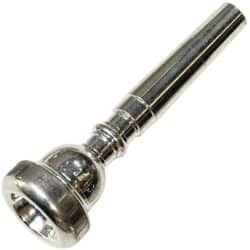Vincent Bach trumpet mouthpieces come in many different models so that each player can find the best fit for them, as no two players have the same lip or tooth formation. When selecting a Bach trumpet, cornet, or fluegelhorn mouthpiece, a brass instrumentalist should choose one that allows them to produce a solid, compact tone of large volume. A carefully selected Bach mouthpiece can help improve a player’s embouchure, attack, tonguing, and endurance.
The majority of trumpet players have played a Vincent Bach mouthpiece at some point, and the vast majority of new trumpets come with a 7C trumpet mouthpiece, either a genuine Vincent Bach 7C or a copy of this model (or sometimes just stamped “7C” but bearing no relation to the original).
The history of Bach starts with mouthpieces. A century ago, trumpet player Vincent Bach began experimenting with designs and manufacturing processes to replace a broken mouthpiece. Soon after, his mouthpieces, and later his trumpets, set the standard for excellence. We continue that standard today through constant innovation and dedication to the craft. In the Bach workshop, crafting a mouthpiece begins with innovative, yet classic designs and is then carved by a computer-numeric-controlled machine that shapes and cuts solid brass bars. Each step is precise within one ten-thousandth of an inch.
One of the most famous orchestral trumpet players ever, Adolf Herseth, played a Bach number 1 mouthpiece with a 22 throat. Virtuoso Gerard Schwartz played a Bach 3C on all his trumpets but with a larger throat for the smaller instruments, the biggest throat he used was for the Piccolo Bb trumpet.
-
Second Hand Trumpet Mouthpieces, Standard, Trumpet mouthpieces
Second Hand Bach 17C Trumpet Mouthpiece
£40.00In fairly good condition. There is some wear to the plating on the rim but it has not worn through to the brass.
Online price. In-store price may vary.
Out of stock
-
Trumpet mouthpieces, Vincent Bach Trumpet Mouthpieces
Vincent Bach 7C Trumpet Mouthpiece
£60.00One of the most widely used and copied mouthpieces in the world. Helps to produce a bright sound with easy flexibility.
17 in stock
-
Second Hand Trumpet Mouthpieces, Trumpet mouthpieces, Vincent Bach Trumpet Mouthpieces
Second Hand Bach 1.5C Trumpet Mouthpiece
£50.00This Second Hand Bach 1.5C Trumpet Mouthpiece is in good condition with plating wear on the shank
1 in stock
-
Trumpet mouthpieces, Vincent Bach Trumpet Mouthpieces
Second Hand Bach trumpet mouthpiece model 3
£50.00Second Hand Bach trumpet mouthpiece number 3 in very good condition. Some wear to the shank but the cup and rim are both perfect.
16.3mm cup diameter
Deep cup
Medium wide rimFairly large…
1 in stock
-
Second Hand Trumpet Mouthpieces, Trumpet mouthpieces, Vincent Bach Trumpet Mouthpieces
Vintage Besson Prototype Trumpet Mouthpiece
£50.00Besson Prototype Trumpet Mouthpiece. A good all rounder. Aesthetically similar to some of the old Conn mouthpiece models
1 in stock
-
Second Hand Trumpet Mouthpieces, Trumpet mouthpieces, Vincent Bach Trumpet Mouthpieces
Second Hand Vincent Bach 7C Trumpet Mouthpiece
£50.00One of the most widely used and copied mouthpieces in the world. Helps to produce a bright sound with easy flexibility.
1 in stock
-
Trumpet mouthpieces, Vincent Bach Trumpet Mouthpieces
Vincent Bach 1B Trumpet Mouthpiece
£80.00Large cup size for players with a robust embouchure. It produces a warm tone with great volume and is often used by orchestral players, particularly those required to play low…
2 in stock
-
Trumpet mouthpieces, Vincent Bach Trumpet Mouthpieces
Vincent Bach 1D Trumpet Mouthpiece
£80.00Medium shallow cup facilitates high register. Produces a brilliant sound. 17mm cup diameter,
medium shallow cup, medium wide rim.Online price. In-store price may vary.
2 in stock
-
Trumpet mouthpieces, Vincent Bach Trumpet Mouthpieces
Vincent Bach 12C Trumpet Mouthpiece
£80.00Brilliant tone, with easy high register for trumpeters who have to play forte in the upper range and for players with heavy, weak lips who have difficulty with the high…
Out of stock
-
Trumpet mouthpieces, Vincent Bach Trumpet Mouthpieces
Vincent Bach 18C Trumpet Mouthpiece
£80.00The same cup design as No.17C, with a wider and flatter rim to distribute pressure over a larger surface. Produces a lively, clear and brilliant tone.
Online price. In-store price may…
1 in stock
-
Trumpet mouthpieces, Vincent Bach Trumpet Mouthpieces
Vincent Bach 1C Trumpet Mouthpiece
£80.00Large diameter (17mm) with a medium cup, ideal for all-round use. Popular with orchestral players.
Online price. In-store price may vary.
3 in stock
-
Trumpet mouthpieces, Vincent Bach Trumpet Mouthpieces
Vincent Bach 1 Trumpet Mouthpiece
£80.0017.50mm diameter with a deep cup. Extra-large cup for players with a robust embouchure. Produces a great volume of tone.
Online price. In-store price may vary.
5 in stock






